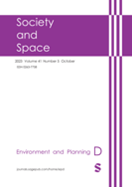
How did the arrival of growing numbers of refugees and other migrants in a non-violent setting and high-income country like Norway become framed as a ‘humanitarian crisis’? Is there a humanitarian crisis if nobody dies?
Looking back at the reception of refugees and other migrants in Norway in 2015-2016, this new article in Environment and Planning D: Society and Space seeks to understand how the ‘humanitarian’ and ‘crisis’ frames were mobilized by different kinds of actors (humanitarian organizations, citizen volunteers, the state and local municipalities) - and which consequences it had.
By examining the framing and responses to the influx of refugees and other migrants to Norway in 2015–16, the authors Maria Gabrielsen Jumbert, Kristin Bergtora Sandvik and Mathias Hatleskog look at how this unfolded in and around Oslo and in the Arctic region of Storskog, along the Russian border. Their analysis draws on two theoretical contributions: work on ‘crisis and chaos’ and the idea of ‘chaotic geographies’, and work on the ‘humanitarian arena’ . Taking a tripartite approach, they study how time, space and different levels of response (citizen volunteers, established humanitarian actors and the state) contributed to the framing of the situation as a humanitarian crisis, and the consequences of this. They show that Norway is a political and geographical outlier, and that the state’s response to this ‘humanitarian crisis’ and potentially chaotic situation was seen as both appropriate and legitimate. They argue this helped ‘de-escalate’ the chaotic geography.
The article “If ‘it all breaks down’: The Norwegian refugee crisis as a geography of chaos” is Open access, available here: https://journals.sagepub.com/doi/10.1177/02637758231203822





